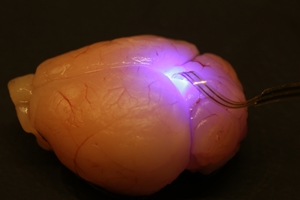Biomedical engineers at University of Illinois in Champaign, with colleagues from Washington University in St. Louis, and other institutions in the U.S., Korea, and China developed tiny light-emitting diode (LED) devices that can be injected deep in the brain to study neural functions. The team led by Illinois’s John Rogers published its findings in this week’s issue of the journal Science (paid subsciption required).
The technology devised by the researchers enables highly miniaturized biocompatible electronics to be implanted deep into tissue, including brain tissue, with a thin, releasable micro-injection needle. An ultrathin ribbon connects the implanted device to a wireless antenna and an energy harvesting circuit that powers the devices.
The team demonstrated its first application of the technology with an optogenetic device that uses light to stimulate targeted neural pathways in the brain, and study precise, isolated brain functions in ways that were previously impossible. In the Science paper, Rogers and colleagues reported on genetically programming specific neurons to respond to light.
The researchers designed tiny LED circuits about the size of individual human cells at the tip of of a flexible plastic ribbon thinner than a human hair and narrower than an eye of a needle. The tiny circuitry, say the researchers, can be inserted deep into the brain with very little stress to the surrounding tissue.
The researchers genetically engineered the neurons of lab mice to respond to stimuli from light. The light given off by the implanted LEDS stimulated the altered neurons in the test mice, giving off dopamine and other neurotransmitters. Dopamine is a chemical that helps control the brain’s reward and pleasure centers, as well as movement and emotional responses to fulfill those rewards. The ability to study the brain in this way opens potential uses in developing treatments for neurological disorders such as Alzheimer’s disease, Parkinson’s disease, and depression.
The results of this study suggests the technology could be expanded to electronic circuis that could be injected deep in tissue elsewhere in the body. Rogers says, for example, his lab developed devices for stimulating peripheral nerves in the leg as a technology that could help manage pain. “Many cases, ranging from fundamental studies to clinical interventions, demand access directly into the depth,” notes Rogers. “This is just the first of many examples of injectable semiconductor microdevices that will follow.”
Read more:
- U.S. Patent Awarded for Protein Therapy Delivery Technology
- University Consortium to Research Nanotech Health Monitors
- Two Paralyzed People Use Brain-Controlled Robotic Arms
- Efficient, Economical Brain Imaging System in Development
- Medical Sensor Powered by Music Vibrations Developed
* * *


 RSS - Posts
RSS - Posts
[…] Injectable LEDs Developed to Study Brain Functions […]